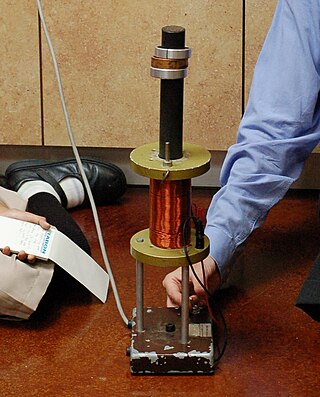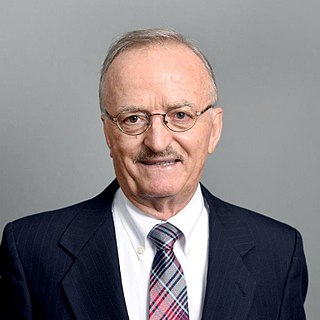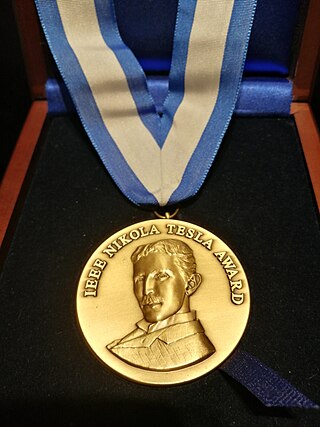
Electrodynamic suspension (EDS) is a form of magnetic levitation in which there are conductors which are exposed to time-varying magnetic fields. This induces eddy currents in the conductors that creates a repulsive magnetic field which holds the two objects apart.

A magnetic bearing is a type of bearing that supports a load using magnetic levitation. Magnetic bearings support moving parts without physical contact. For instance, they are able to levitate a rotating shaft and permit relative motion with very low friction and no mechanical wear. Magnetic bearings support the highest speeds of any kind of bearing and have no maximum relative speed.
Electromagnetic propulsion (EMP) is the principle of accelerating an object by the utilization of a flowing electrical current and magnetic fields. The electrical current is used to either create an opposing magnetic field, or to charge a field, which can then be repelled. When a current flows through a conductor in a magnetic field, an electromagnetic force known as a Lorentz force, pushes the conductor in a direction perpendicular to the conductor and the magnetic field. This repulsing force is what causes propulsion in a system designed to take advantage of the phenomenon. The term electromagnetic propulsion (EMP) can be described by its individual components: electromagnetic – using electricity to create a magnetic field, and propulsion – the process of propelling something. When a fluid is employed as the moving conductor, the propulsion may be termed magnetohydrodynamic drive. One key difference between EMP and propulsion achieved by electric motors is that the electrical energy used for EMP is not used to produce rotational energy for motion; though both use magnetic fields and a flowing electrical current.

Maglev is a system of rail transport whose rolling stock is levitated by electromagnets rather than rolled on wheels, eliminating rolling resistance.

Electromagnetic suspension (EMS) is the magnetic levitation of an object achieved by constantly altering the strength of a magnetic field produced by electromagnets using a feedback loop. In most cases the levitation effect is mostly due to permanent magnets as they have no power dissipation, with electromagnets only used to stabilise the effect.

The SCMaglev is a magnetic levitation (maglev) railway system developed by Central Japan Railway Company and the Railway Technical Research Institute.

Computational electromagnetics (CEM), computational electrodynamics or electromagnetic modeling is the process of modeling the interaction of electromagnetic fields with physical objects and the environment using computers.

Constantine A. Balanis is a Greek-born American scientist, educator, author, and Regents Professor at Arizona State University. Born in Trikala, Greece on October 29, 1938. He is best known for his books in the fields of engineering electromagnetics and antenna theory. He emigrated to the United States in 1955, where he studied electrical engineering. He received United States citizenship in 1960.
Petar V. Kokotovic is professor emeritus in the College of Engineering at the University of California, Santa Barbara, USA. He has made contributions in the areas of adaptive control, singular perturbation techniques, and nonlinear control especially the backstepping stabilization method.

The IEEE Nikola Tesla Award is a Technical Field Award given annually to an individual or team that has made an outstanding contribution to the generation or utilization of electric power. It is awarded by the Board of Directors of the IEEE. The award is named in honor of Nikola Tesla. This award may be presented to an individual or a team.
Leopold B. Felsen was an electrical engineer and physicist known for studies of electromagnetism and wave-based disciplines. He had to flee Germany at 16 due to the Nazis. He has fundamental contributions to applied electromagnetic field analysis.

Nathan Marcuvitz was an American electrical engineer, physicist, and educator who worked in the fields of microwave and electromagnetic field theory. He was head of the experimental group of the Radiation Laboratory (MIT). He was a member of the National Academy of Engineering. He had a PhD in electrical engineering from Polytechnic Institute of Brooklyn.

Magnetic levitation (maglev) or magnetic suspension is a method by which an object is suspended with no support other than magnetic fields. Magnetic force is used to counteract the effects of the gravitational force and any other forces.
Isaak D. Mayergoyz is the Alford L. Ward Professor of the Department of Electrical and Computer Engineering at the University of Maryland, College Park.
Electromagnetically induced acoustic noise, electromagnetically excited acoustic noise, or more commonly known as coil whine, is audible sound directly produced by materials vibrating under the excitation of electromagnetic forces. Some examples of this noise include the mains hum, hum of transformers, the whine of some rotating electric machines, or the buzz of fluorescent lamps. The hissing of high voltage transmission lines is due to corona discharge, not magnetism.

Weng Cho Chew is a Malaysian-American electrical engineer and applied physicist known for contributions to wave physics, especially computational electromagnetics. He is a Distinguished Professor of Electrical and Computer Engineering at Purdue University.
Roger Fuller Harrington is an American electrical engineer and professor emeritus at Syracuse University. He is best known for his contributions to computational electromagnetics with his development of method of moments (MoM). Harrington's 1968 book, Field Computation by Moment Methods, is regarded as a pivotal textbook on the subject.

The method of moments (MoM), also known as the moment method and method of weighted residuals, is a numerical method in computational electromagnetics. It is used in computer programs that simulate the interaction of electromagnetic fields such as radio waves with matter, for example antenna simulation programs like NEC that calculate the radiation pattern of an antenna. Generally being a frequency-domain method, it involves the projection of an integral equation into a system of linear equations by the application of appropriate boundary conditions. This is done by using discrete meshes as in finite difference and finite element methods, often for the surface. The solutions are represented with the linear combination of pre-defined basis functions; generally, the coefficients of these basis functions are the sought unknowns. Green's functions and Galerkin method play a central role in the method of moments.
This page is based on this
Wikipedia article Text is available under the
CC BY-SA 4.0 license; additional terms may apply.
Images, videos and audio are available under their respective licenses.












